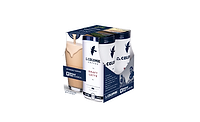2018 State of the Beverage Industry: Premiumization in the coffee category drives majority of sales
Overall coffee category experiencing modest gains

Consumers are constantly looking for ways to get their daily caffeine fix and industry data shows this won’t be changing anytime soon. According to Chicago-based Mintel’s July 2017 report titled “Coffee – US,” 83 percent of adults drink some type of coffee at home.
Industry experts note increased coffee sales as the result of increased consumption among younger generations. “Younger adults are more engaged coffee consumers, having grown up with diverse and high-end offerings, such as Starbucks…,” the Mintel report explains. “Individuals in the iGen and millennial generations are more likely than their older counterparts to be drinking more coffee throughout the day than they did a year ago…”
Yet, increased consumption is not the only factor that is boosting the coffee market, explains Chrystalleni Stivaros, analyst at Los Angeles-based IBISWorld, in Beverage Industry’s September 2017 issue. Premiumization trends are impacting the overall category as well, with gourmet coffees expected to comprise more than half of coffee consumed this year, she adds.
Although in its report, Mintel stated that coffee sales are estimated to slow, opportunities exist to reinvigorate sales, particularly by reaching the highly engaged iGen and millennial consumers. This leaves room for the proliferation of a variety of coffee products to drive growth for the coffee category, experts say.
(Individual brands)
| Dollar Sales | % CHANGE VS. PRIOR YEAR | MARKET SHARE | % CHANGE VS. PRIOR YEAR | |
| Folgers | $1,108,413,312 | -4.5 | 27.4 | -1.5 |
| Maxwell House | $522,368,736 | -6.6 | 12.9 | -0.9 |
| Starbucks | $445,092,864 | 6.8 | 10.9 | 0.7 |
| Private label | $436,487,776 | 16.5 | 10.8 | 1.5 |
| Category total* | $4,050,696,704 | 0.5 | 100.0 | — |
Source: Information Resources Inc. (IRI), Chicago. Total U.S. supermarkets, drug stores, gas and convenience stores, mass merchandisers, military commissaries, and select club and dollar retail chains for the 52 weeks ending May 20.
Data from Chicago-based Information Resources Inc. (IRI) coincides with Mintel’s report. Dollar sales for the ground coffee category accounted for $4 billion for the 52 weeks ending May 20 in total U.S. multi-outlets and convenience stores, showing a primarily flat growth rate of 0.48 percent, IRI data states.
In the past year, single-cup coffees also have seen relatively stagnant growth. The category grew 4.2 percent, from $3.9 billion last year, now accounting for $4.1 billion overall single-cup coffee sales for the last 52 weeks ending May 20.
(Individual brands)
| Dollar Sales | % CHANGE VS. PRIOR YEAR | MARKET SHARE | % CHANGE VS. PRIOR YEAR | |
| Private label | $852,834,560 | 15.9 | 20.8 | 2.1 |
| Starbucks | $677,007,616 | 7.5 | 16.5 | 0.5 |
| Keurig Green Mountain | $446,183,264 | 3.5 | 10.9 | -0.1 |
| Dunkin Donuts | $309,503,744 | 20.5 | 7.5 | 1.0 |
| Keurig Donut Shop | $250,539,328 | -4.5 | 6.1 | -0.6 |
| Category total* | $4,103,355,904 | 4.2 | 100.0 | — |
Source: Information Resources Inc. (IRI), Chicago. Total U.S. supermarkets, drug stores, gas and convenience stores, mass merchandisers, military commissaries, and select club and dollar retail chains for the 52 weeks ending May 20.
“Coffee pods helped to revolutionize the homebrewing coffee segment with an easier, faster, more convenient method of coffee brewing,” said Gary Hemphill, managing director of research for New York-based Beverage Marketing Corporation (BMC), in Beverage Industry’s September 2017 issue. “Sales of coffee pods have slowed from their lofty growth years ago.”
Yet, refrigerated ready-to-drink (RTD) coffees saw an overall 18.8 percent increase from last year, reaching a category total of $3.2 million for the last 52 weeks ending May 20 in total U.S. multi-outlets and convenience stores, IRI data suggests.
“RTD coffees are still on the rise,” IBISWorld’s Stivaros explained in Beverage Industry’s September 2017 issue. “Millennials are maintaining its popularity. The fast-paced lifestyle of Americans creates a need for quick options, especially in the morning. Furthermore, RTD coffees are consumed cold, piggy-backing on the very popular iced coffee and cold-brew coffee trends.”
(Individual brands)
| Dollar Sales | % CHANGE VS. PRIOR YEAR | MARKET SHARE | % CHANGE VS. PRIOR YEAR | |
| International Delight | $61,387,080 | -4.0 | 19.0 | -4.5 |
| Starbucks | $60,674,520 | 36.6 | 18.8 | 2.5 |
| Starbucks Iced Espresso Classics | $50,281,952 | -1.3 | 15.6 | -3.2 |
| Stok | $43,316,984 | 96 | 13.5 | 5.3 |
| Califia Farms | $26,122,040 | -12.2 | 8.1 | -2.9 |
| Category total* | $322,099,104 | 18.8 | 100.0 | — |
Source: Information Resources Inc. (IRI), Chicago. Total U.S. supermarkets, drug stores, gas and convenience stores, mass merchandisers, military commissaries, and select club and dollar retail chains for the 52 weeks ending May 20.
BMC’s Hemphill also expects continued growth in the RTD coffee segment. “We project sold growth for ready-to-drink coffee in the years ahead,” he says. “It remains relatively under-developed and continues to be dominated by the partnership between Starbucks and PepsiCo. We believe the category is likely to see more new players, more innovation and healthy growth in years ahead.”
Industry experts believe that the premiumization trends saturating the coffee category could benefit all coffee segments going forward. In Beverage Industry’s July 2017 issue, IBISWorld’s report stated: “Consumers are increasingly demanding specialized, high-quality coffee products, particularly in single-use servings. Over the past five years, many consumers have viewed high-quality industry products as an affordable luxury.” BI
Looking for a reprint of this article?
From high-res PDFs to custom plaques, order your copy today!





